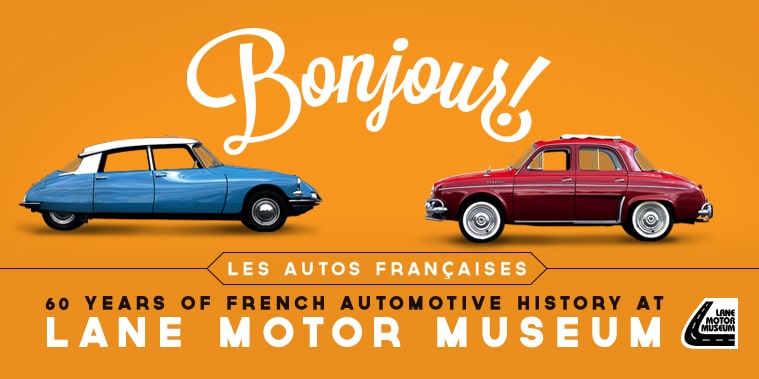Les Autos Françaises: 60 Years of French Automotive History – On Display May 21, 2015 – April 4, 2016
This summer Lane Motor Museum brings you “Les Autos Françaises: 60 Years of French Automotive History,” focusing on 60 of the 120 years of car production in France. Starting in the 1890s, France remained the largest producer of cars in Europe until after WWI. In fact, from 1902-1907, France produced more cars than the rest of Europe combined. The United States did not out-produce France until after 1907.
What made France such a leader in the beginning? There were three major reasons: First, they had an excellent road system that allowed early, rudimentary cars to be driven almost everywhere; second, France’s high level of technical competence, from bicycles to steam trains; and lastly, France had an abundance of energetic and talented entrepreneurs.
In 1913, there were 31 major French car makers, and many smaller car companies. Although other countries eventually caught up with, and surpassed, French car production, the French manufacturers remained alive and innovative. Citroën was a major manufacturer with many technologically significant cars, starting with the Traction Avant in 1934, and continuing with the 2CV in 1950 and later, the ID19, which stunned every attendee of the 1955 Paris Auto Show. Although Citroën was a large company with technologically-advanced cars, there were many smaller manufacturers that turned out unique and interesting cars, such as Georges Irat, Matra, Rovin, Hotchkiss-Gregoire, Panhard, Simca, and many more.
Lane Motor Museum will be displaying 30 of the most unique French cars from the 100+ French cars in the collection, focusing on the heyday of French production – 1924-1985.
The Choice- by Jeff Lane, Director
With over 100 French cars in our collection, one would think it easy to do an exhibit called “All Things French”. Actually, it was very, very difficult, and the biggest problem was pruning 100 cars down to 30.
I started with Citroëns since we have about 50, and Citroën was one of the larger French manufacturers, and without a doubt, the most innovative. Citroën started later than some makers, beginning production in 1919. They more than made up for their late start by being hugely innovative. The Traction Avant began production in 1934, and was the first front-wheel drive, steel unibody production car. It remained in production until 1953, and sold in large numbers. As if the 19-year success story of the Traction Avant was not enough, in October 1955, Citroën introduced the DS at the Paris Motor Show. The DS was the first mass-produced car with front-wheel power brakes. It also featured a self-leveling hydropneumatic suspension system. In short, the DS was a technical sensation clad by a futuristic aerodynamic body. Ride quality and handling were unmatched for the day. In fact the ride quality, 60 years later, has not been improved on. The DS was such a successful car that Citroën did not introduce another clean-sheet-design car until the 1970s.
Moving away from Citroën, I tried to choose several unique examples from the three other large French manufacturers: Renault, Panhard, and Peugeot. Renault is a volume French car maker that still survives. Known for conservative cars and leadership, it has always been very successful in France, yet less so in the rest of the world. Panhard was a very early car manufacturer, starting production in 1890. Before WWII, Panhard made mostly upmarket cars. After WWII, they declined, and made more middle to low-end cars, mostly with 2-cylinder, air-cooled engines. Peugeot has always been Renault’s rival in France, and has enjoyed tremendous success in their 100+ years of production.
France has had four major car makers, but throughout their history, they have also had hundreds of others. While many of them were not large or long-lived, they made unique and interesting cars. Georges Irat, Matra, Hotchkiss-Gregoire, and Deutsch-Bonnet are three examples featured in this exhibit.
To complete the exhibit, I picked six of the most interesting French microcars plus the Helicron, which is propeller-driven! Not an easy choice, as I made list upon list, and finally whittled it down to 30 unique and special French cars that are a major part of automotive history.

